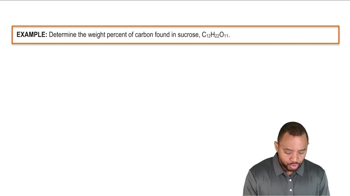The U.S. quarter has a mass of 5.67 g and is approximately 1.55 mm thick. (c) How much money would this stack contain?
Ch.1 - Introduction: Matter, Energy, and Measurement
Chapter 1, Problem 83
By using estimation techniques, determine which of the following is the heaviest and which is the lightest: a 10-lb bag of fertilizer, a 10-kg bag of rice, or 2 gal of olive oil (density = 0.918 g/cm³).
 Verified step by step guidance
Verified step by step guidance1
Convert the weight of the 10-lb bag of fertilizer to kilograms using the conversion factor 1 lb = 0.453592 kg.
The 10-kg bag of rice is already in kilograms, so no conversion is needed.
Convert the volume of 2 gallons of olive oil to liters using the conversion factor 1 gal = 3.78541 L.
Convert the volume of olive oil from liters to cubic centimeters using the conversion factor 1 L = 1000 cm³.
Calculate the mass of the olive oil using the formula mass = density × volume, where the density is given as 0.918 g/cm³, and convert the mass from grams to kilograms using the conversion factor 1 kg = 1000 g.
Key Concepts
Here are the essential concepts you must grasp in order to answer the question correctly.
Unit Conversion
Unit conversion is the process of converting a quantity expressed in one set of units to another. In this question, it is essential to convert the weights of the fertilizer and rice from pounds and kilograms to a common unit, such as grams, to facilitate direct comparison. Understanding how to convert between units using conversion factors is crucial for accurate estimation.
Recommended video:
Guided course

Conversion Factors
Density
Density is defined as mass per unit volume and is a key property of substances. In this question, the density of olive oil is provided, allowing us to calculate its mass based on its volume. By applying the formula density = mass/volume, we can determine the mass of the olive oil in grams, which is necessary for comparing it with the other items.
Recommended video:
Guided course

Density Concepts
Mass vs. Weight
Mass and weight are often confused but are distinct concepts. Mass is a measure of the amount of matter in an object, typically measured in grams or kilograms, while weight is the force exerted by gravity on that mass, measured in pounds or newtons. Understanding this difference is important when comparing the weights of the items in the question, as it influences how we interpret the values given.
Recommended video:
Guided course

Mass Percent Example
Related Practice
Textbook Question
1
views
Textbook Question
A watt is a measure of power (the rate of energy change) equal to 1 J/s. (b) An adult person radiates heat to the surroundings at about the same rate as a 100-watt electric incandescent light bulb. What is the total amount of energy in kcal radiated to the surroundings by an adult over a 24 h period?
Textbook Question
Two spheres of equal volume are placed on the scales as shown. a. Which one is more dense?
Textbook Question
Water has a density of 0.997 g/cm3 at 25 °C; ice has a density of 0.917 g/cm3 at -10 °C. (a) If a soft-drink bottle whose volume is 1.50 L is completely filled with water and then frozen to -10 °C, what volume does the ice occupy? (b) Can the ice be contained within the bottle?
